The 2022 World Cup might be providing fans, objectors and organisations with plenty of discussion points off the field, but there has also been plenty to talk about on the pitch too. The fourth day of action saw Canada make their bow in Qatar, with John Herdman’s Maple Leafs featuring in the finals tournament for the first time since Mexico 1986, and their first assignment was a meeting with 2018 semi-finalists Belgium, who are one of the sides backed to advance far into the knockout stages.
However, as this tactical analysis will indicate, Canada didn’t seem worried by the prospect of facing such a strong team and actually offered a lot more than some expected from them, with Belgium finding out first-hand that they will not be a side to underestimate during the group stages. The analysis will specifically identify the key positives and negatives in the North American side’s attacking and defensive tactics, as well as looking at why Belgium struggled to get into the match and what they will need to improve ahead of their next outing.
Lineups
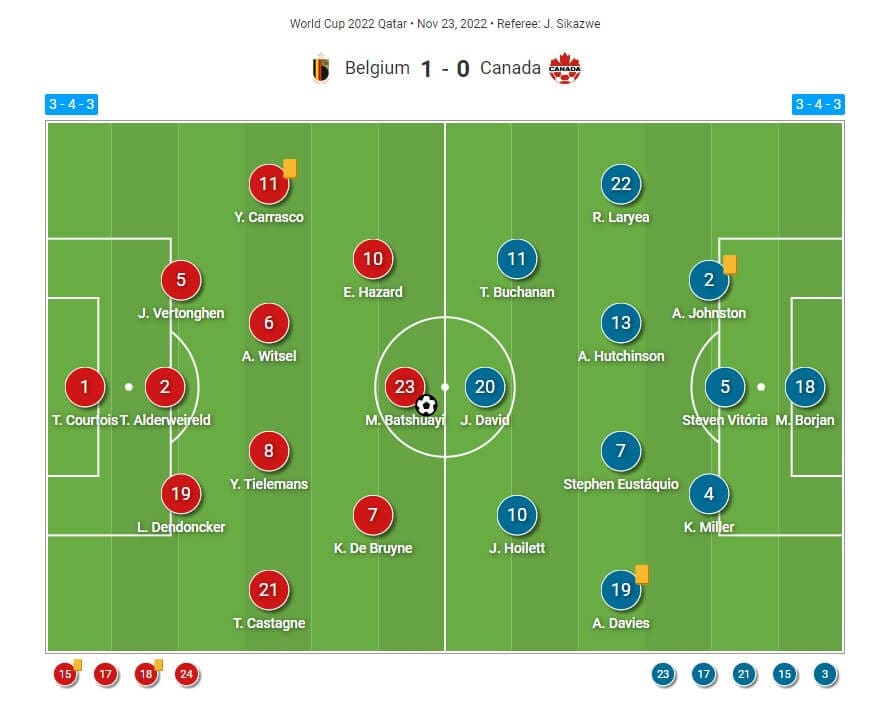
Belgium named a strong side for this match, with Roberto Martínez hoping to get off to a good start as he tried to take his team one stage further and give them a chance of lifting the Jules Rimet trophy in a few weeks’ time. Whilst many names in their starting lineup were expected to play, there were a few surprise selections, including Aston Villa’s Leander Dendoncker, who joined former Tottenham Hotspur duo Toby Alderweireld and Jan Vertonghen in a back three. Inter Milan striker Romelu Lukaku and Borussia Dortmund right-back Thomas Meunier had both picked up injuries in the build-up to this match, with the former ruled out whilst the latter was only fit enough for the bench. Leicester City’s Timothy Castagne was therefore named at right wing-back, whilst Michy Batshuayi led the line.
Canada had also named a strong starting lineup for their first finals match in 36 years, with plenty of recognisable names included. Right-back Richie Laryea has struggled for game time at Nottingham Forest but has shown his true qualities in his two spells at hometown MLS side Toronto, which was enough for Herdman to hand him a start as he also went for wing-backs. The other wide role was claimed by Bayern Munich star Alphonso Davies, whilst Lille forward Jonathan David, who has been linked with a big-money move in January, started in attack ahead of the likes of Cyle Larin and Iké Ugbo.
Canada’s attacking play
When Herdman was in charge of the Canadian women’s team, he implemented a style of play that saw his players get on the front foot and put pressure on their opponents from the first kick of the ball. Since taking over the men’s team in 2018, it has been clear that he has tried to introduce those same ideas to the way they play in matches, and it was one reason that they were successful in sealing a place in the finals.
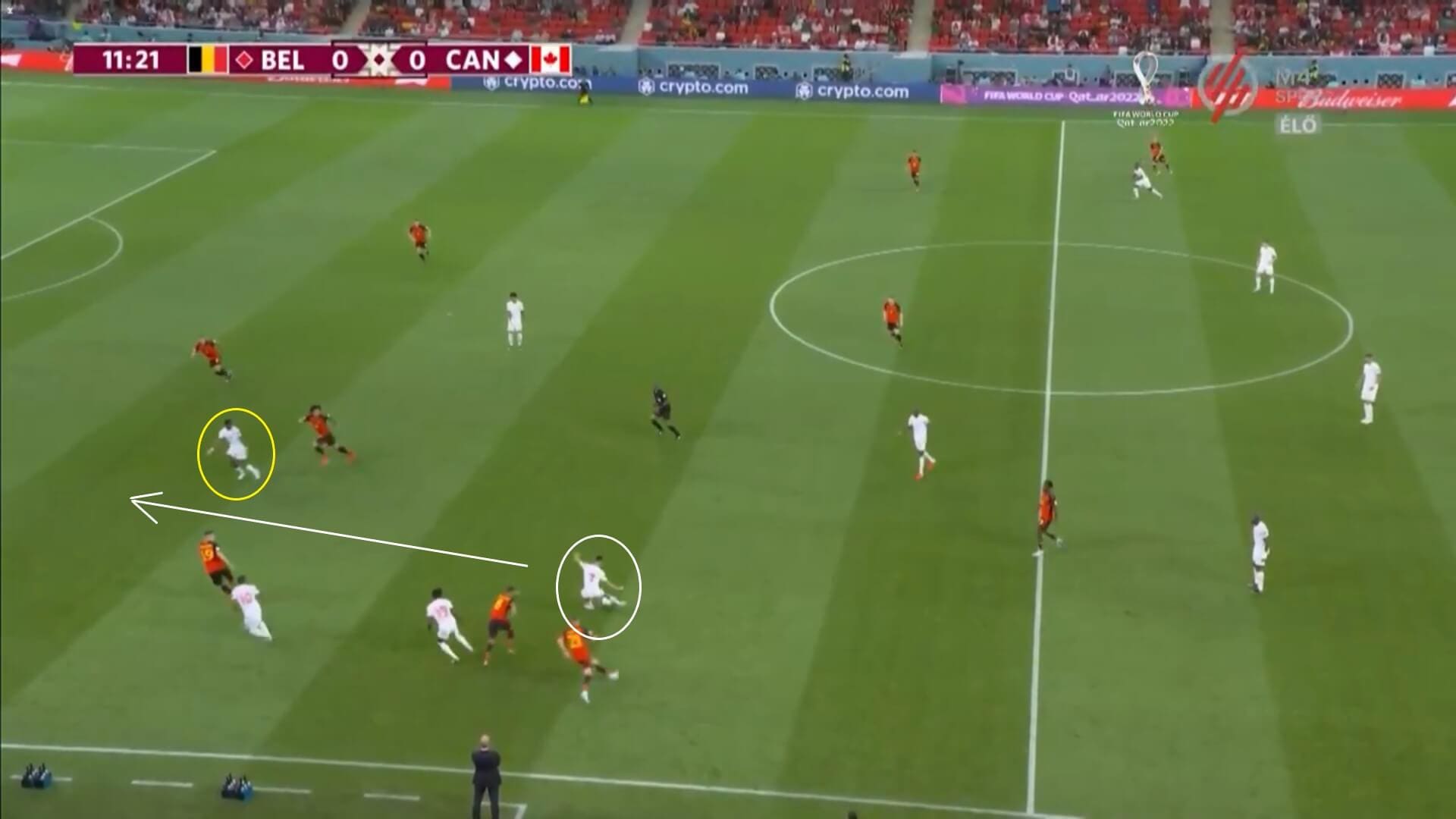
Tactically, it was evident that Herdman was looking for his players to only have one or two touches of the ball at most, with his aim clearly being to make it as difficult as possible for Belgium to close it down. However, while having that mentality is good, it alone won’t lead to them scoring goals, so they also needed to show excellent awareness, know where the spaces were, and how they could keep Belgium on the back foot.
One player who was particularly strong at this was midfielder Stephen Eustáquio, who received the ball and instantly looked ahead of him for a passing option. Reading winger Junior Hoilett has made a run forward here and is now in a position to receive a pass and create an opportunity to shoot at goal, and this early positioning is the key thing here, as it enabled Eustáquio to move the ball out of his feet early and instantly move it forwards, maintaining his side’s momentum, and it was little details like this that showed how Canada were looking to approach the game.
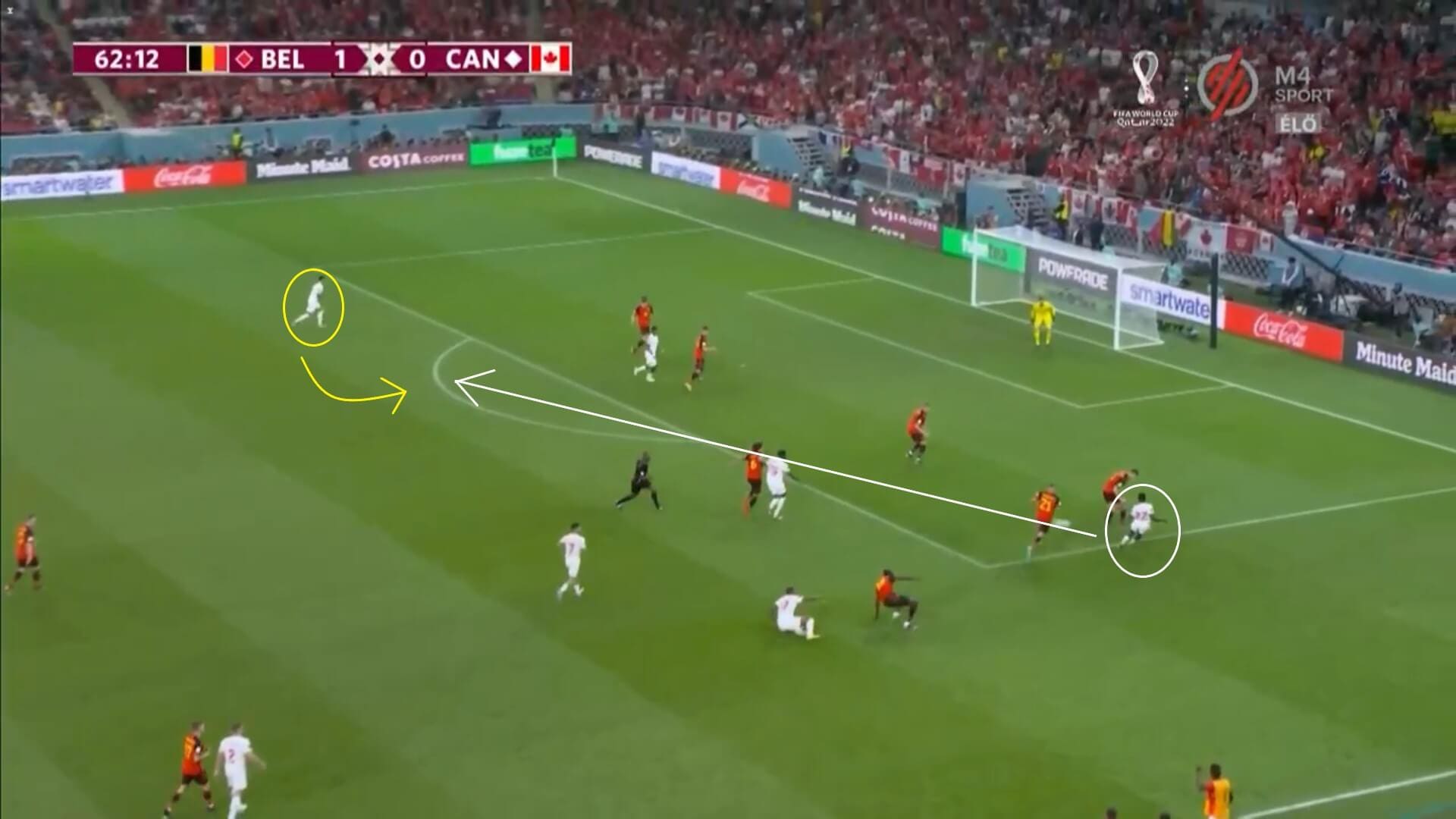
However, whilst anyone who watched the game will agree that Canada were by far the better team in terms of performance levels, what was very noticeable was their lack of an end product. Time after time, they got themselves into these good areas of the pitch and looked like they might find the back of the net, but then couldn’t finish their chances off and let their opponents off.
In this case, Richie Laryea has possession on the edge of the goal area and has pulled it back well, with the arrow illustrating how his accurate pass ensured that his teammates would have time to control the ball before shooting at goal. Therefore, even though wide forward Tajon Buchanan did need to adjust his run here, as the yellow arrow shows, he did have time to settle before connecting with the ball. However, he ended up rushing his effort and sending the ball over the crossbar, wasting the opportunity, and this was not the only time when the Maple Leafs will know that they could have been more composed in these moments and ensured that they had something to show for their efforts at full-time.
Canada’s defensive tactics
Defensively, the North Americans again started well, with them working hard to stifle Belgium’s attempts to move up the field and pose a threat. However, whilst this did successfully keep Belgium quiet for the first part of the game, Martínez’s side eventually found a weakness in the way that they were playing, enabling them to take all three points from this encounter.

Initially, it was clear that Canada wanted to play in a balanced manner when they lost possession, with their aim being to set traps and to try and force Belgium into giving the ball up as rapidly as possible. To do this, they split their outfield players into two groups, with four players here pushing into the final third and looking to prevent a short pass being made, whilst the other six have sat back and are protecting their goal in case of a Belgian break.
What this means is that Thibaut Courtois is now forced to play a long ball up the field, as anything else will allow Canada to win possession deep inside Belgium’s half of the pitch. However, once the ball did begin to travel up the field, the six Canada players’ jobs would be to intercept the clearance and instantly move it back towards Belgium’s goal area, and this happened on a few occasions inside the opening minutes as Canada looked to establish themselves in the game and settle any pre-match nerves.
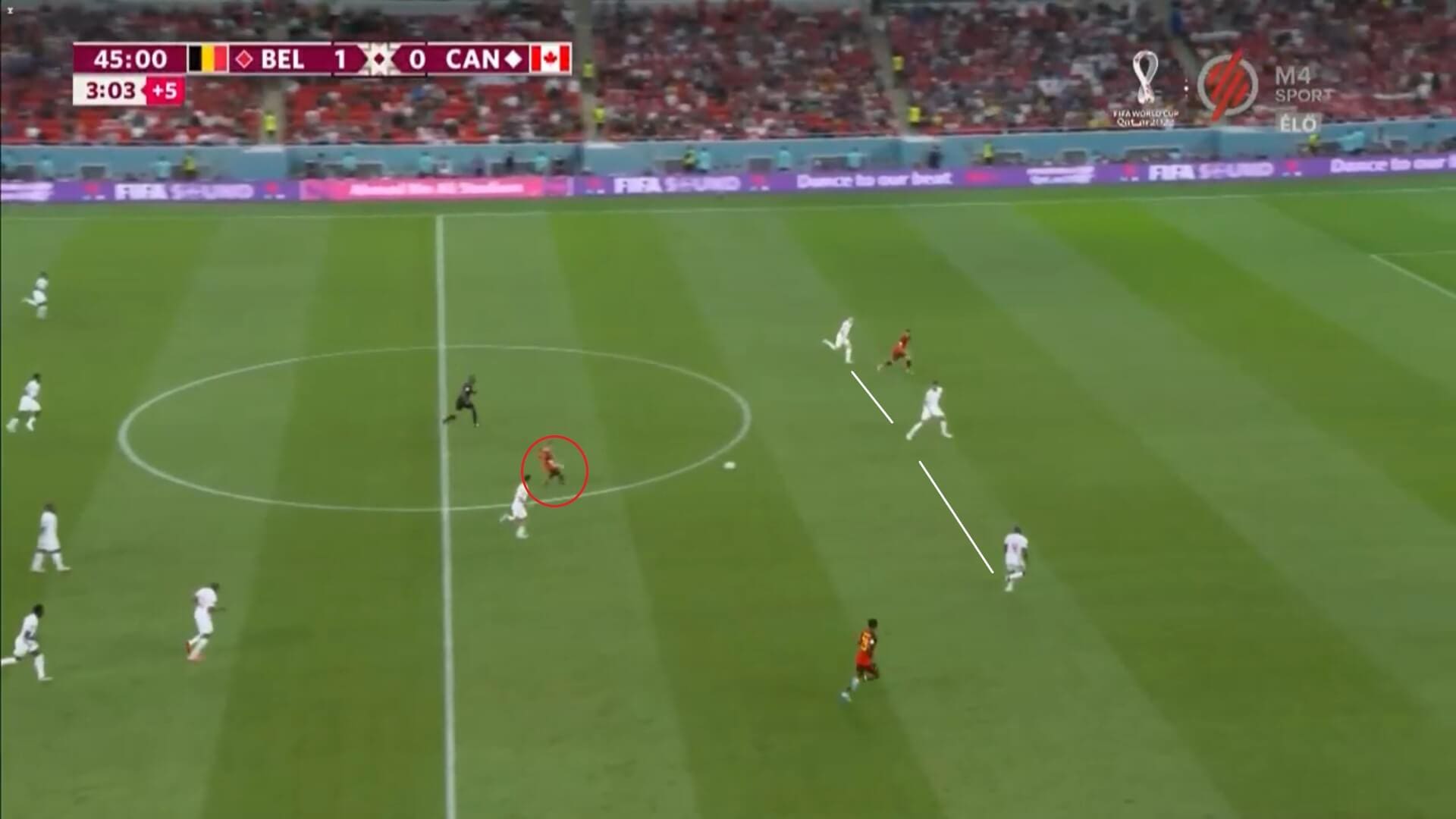
However, in order for that tactic to work, Canada needed to have a robust defensive line and make it as difficult as possible for Belgium to break them down. Initially, as this situation shows, the Maple Leafs showed that strength, with Manchester City playmaker Kevin De Bruyne looking to move the ball up the field here but being unable to locate a gap between Canada’s back three, and all three of Steven Vitória, Kamal Miller and Alistair Johnston continually worked hard to make challenges and intercept the ball, with their individual performances typifying Canada’s overall resilience in the early stages of the game.
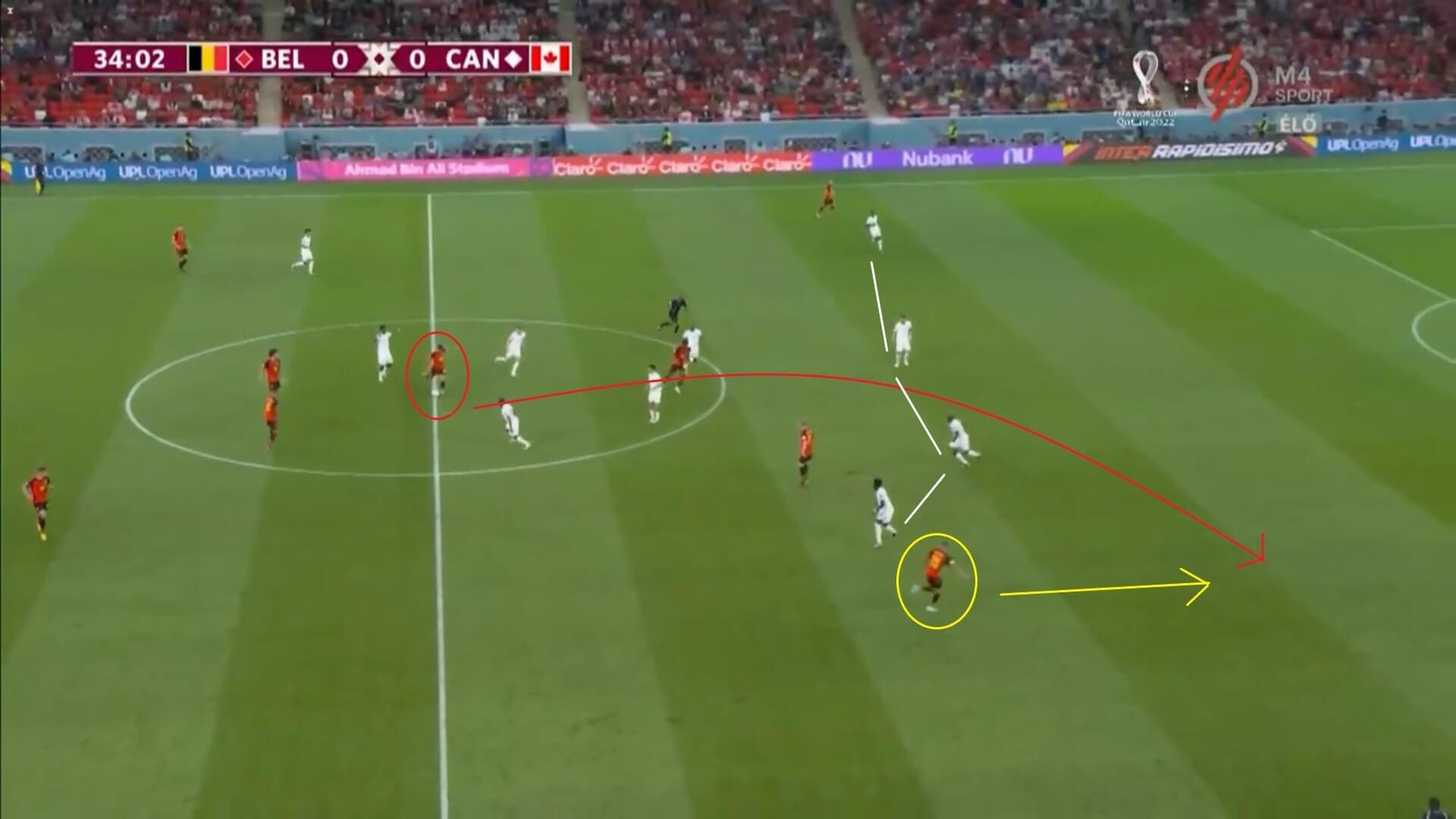
However, as mentioned at the beginning of this section, Belgium did eventually find a way to break their opponents down, and that came through the North Americans’ desire to play with a high back line, which meant that there were vast amounts of space left open behind them.
As a result, it became increasingly common for Belgium’s central midfielders or wide forwards to receive the ball and instantly look for a teammate to make a run, with plenty of high passes being sent into the areas behind Canada’s defensive line. In this case, Eden Hazard has Timothy Castagne running ahead of him and doesn’t hesitate to send the ball in his direction, and, although this particular attack didn’t lead to anything, the only goal of the game came when Toby Alderweireld played a similarly long pass towards Michy Batshuayi on another occasion, with the striker able to find the back of the net that time.
Therefore, whilst Canada deserve a lot of credit for the way that they approached this game tactically and mentally, they will know that Belgium’s goal was the result of a slight structural error on their part, which is a detail that they will need to address ahead of their next game.
Belgium’s poor performance
Whilst this analysis has so far praised the bravery shown by Canada in attack and defence, the same cannot be said for Belgium, with the European side looking slow and lethargic when in possession and lacking organisation when out of it, and they were lucky to come away from this match with all three points in the end.
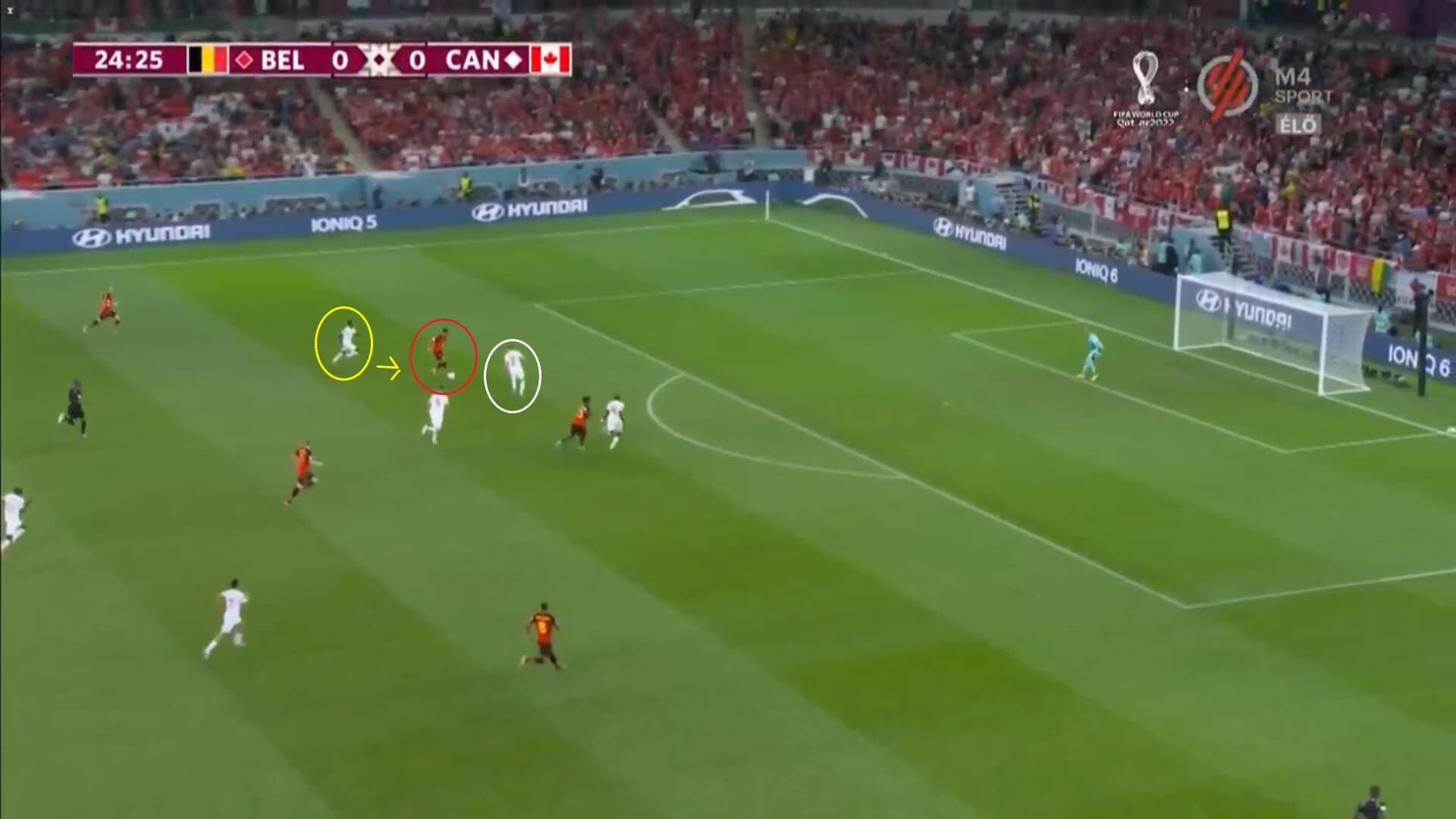
There is no doubt that they do have a lot of talent in their squad, but not all of their key players have been in good form of late. Hazard has struggled to make the same impact at Real Madrid as he did at Chelsea, whilst Atlético Madrid reportedly regret not selling Yannick Carrasco in the summer, with him now mostly featuring as a replacement for Diego Simeone’s side.
As a result, when they got into good positions, they lacked confidence in what they were trying to do, with individual players taking too many touches on the ball and not moving it around quickly enough. This situation shows the result of that, with Hazard in a threatening area of the pitch and with only Johnston ahead of him.
However, rather than looking to move the ball past the CF Montréal defender at this point, he instead holds onto the ball for too long and gives Laryea an opportunity to get back and link up with Johnston, creating a 2-v-1 against Hazard and allowing Canada to clear the danger. This wasn’t the only time that Belgium took too long on the ball, but it showed that they were unsure of what they needed to do and therefore made it easier for Canada to defend against them than it should have been.
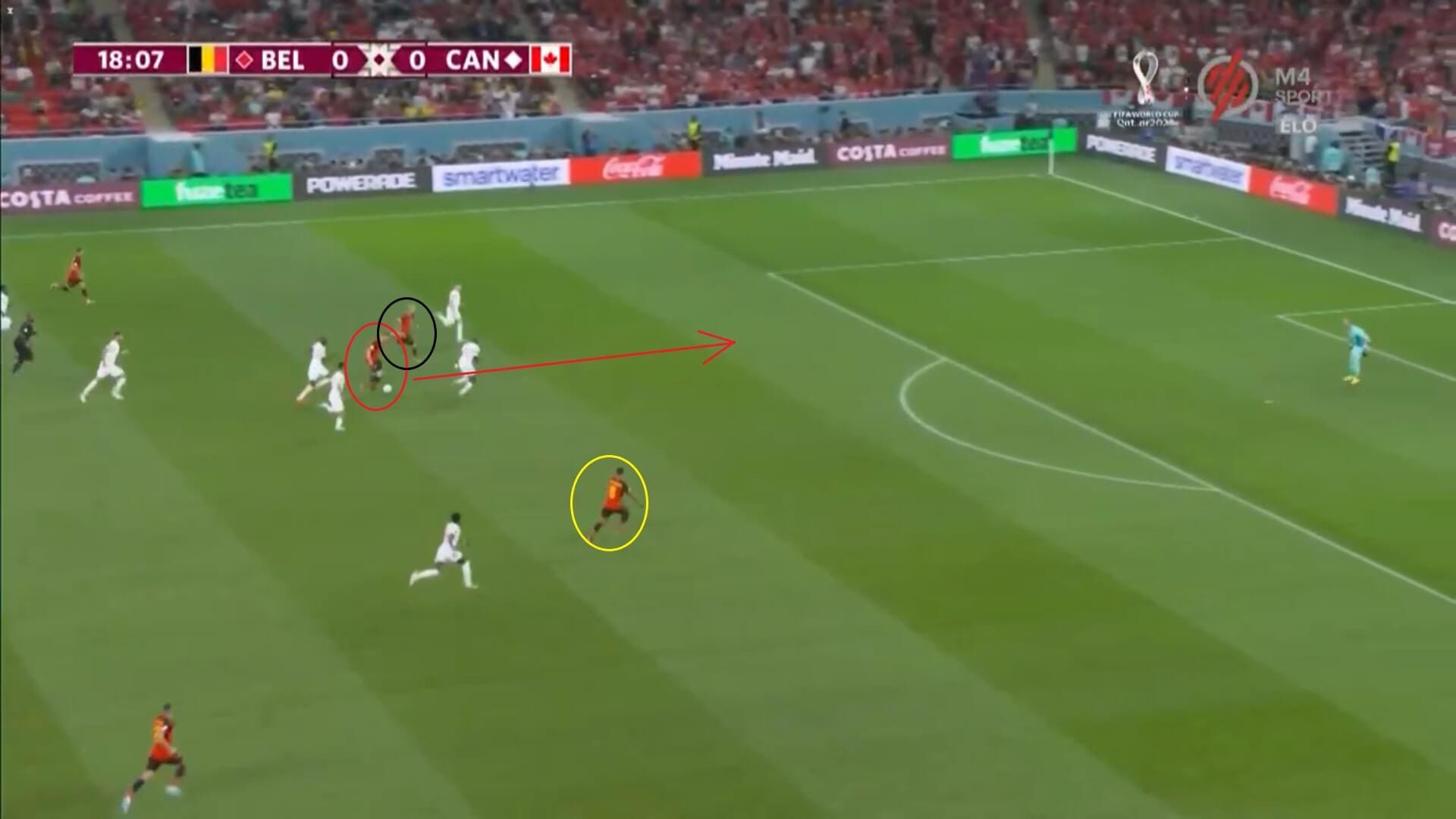
Belgium’s decision-making also let them down at times, with players rarely picking the right pass and therefore again seeing opportunities go begging. In this case, De Bruyne has the ball and there are two players offering him ways to keep the attack alive, with Leicester midfielder Youri Tielemans in space and able to get a shot away at goal whilst Carrasco is not. Therefore, the right move would be to pass to the former here, as this would give Belgium a good chance of finishing this move off.
However, De Bruyne opts to pass towards Carrasco, ignoring Tielemans, and this proves to be the wrong decision as the ball subsequently runs out of play and Canada can again regain possession. Again, this was not the only time that the Belgians had options and chose the wrong one, so this is something that they will need to keep working on as the tournament progresses.
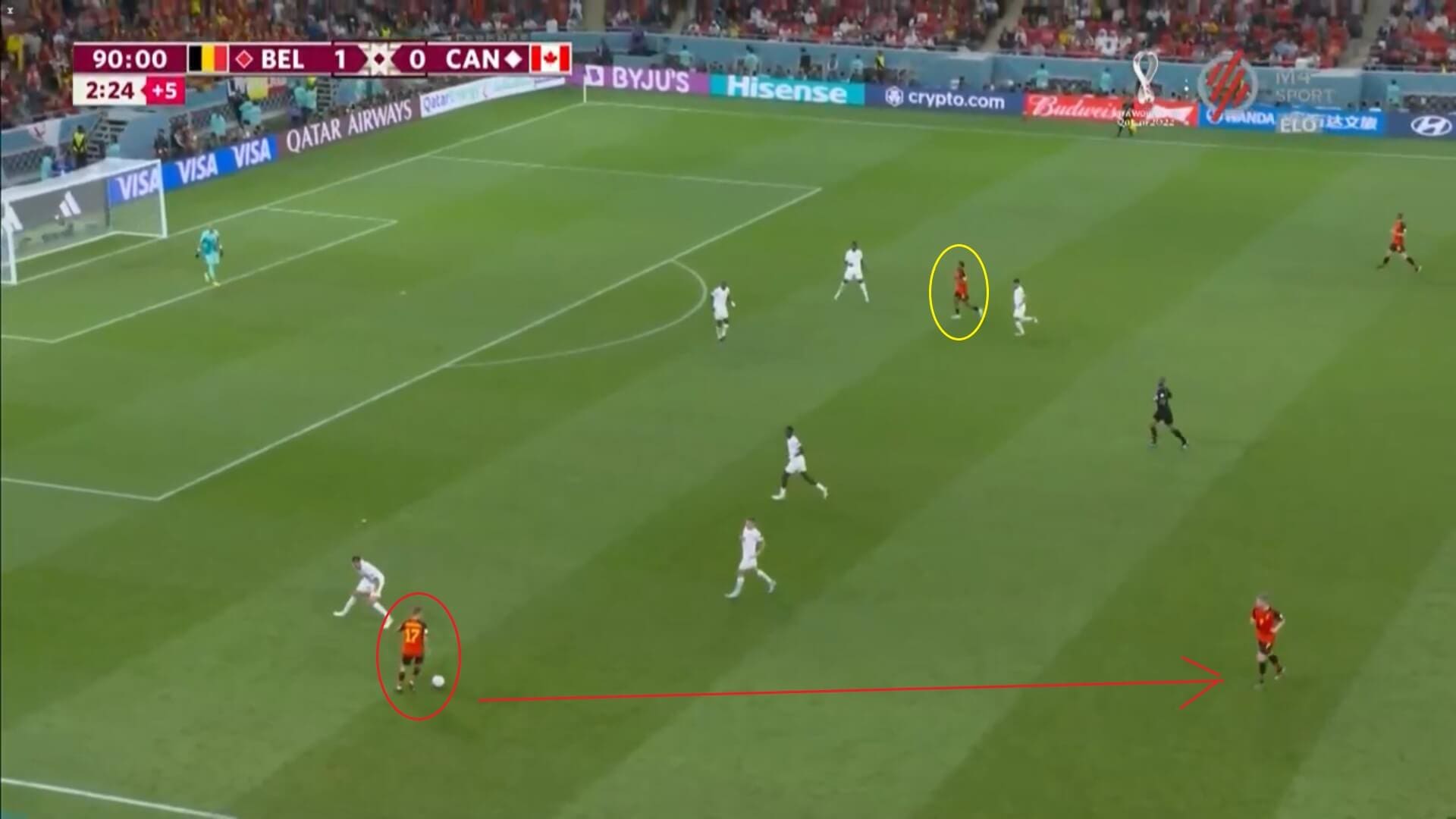
They did slow down as the second half went on, with their aim clearly being to keep possession and not give Canada any opportunity to equalise, but there were still some situations in the latter stages of the game that they will look back on and know that they could have done better. Here, Brighton and Hove Albion’s Leandro Trossard has taken the ball up the field and is now looking for a way to transfer it into the middle, but he doesn’t have any teammates making a move to access the spaces behind Canada’s line and so can’t set up a shot on goal.
Even though this was the end of the match, what was evident was that Belgium weren’t showing any effort to secure their victory with a second goal and were instead happy to settle for one. However, as Argentina and Germany will attest to, this is a very risky way of playing, and it would have been more comfortable for them if they had been like Spain and had kept looking for more goals, and if Belgium are to have any chance of lifting the World Cup trophy, this is the mentality that they will need to have.
Conclusion
In conclusion, this tactical analysis has looked at the World Cup group stage match between Belgium and Canada, with analysis of the Canadians’ attacking and defensive play and an examination of how Belgium were far from their best and will need to improve in their next match.
Whilst this analysis has mentioned that the Maple Leafs were at fault for Belgium’s goal, they should still be proud of their performance and take a lot of positives from it, as they clearly demonstrated that they deserve their place in the finals and will be a team that should not be underestimated.
From Belgium’s point of view, they were fortunate in the end, with them getting off to a winning start but knowing that there is still a lot of work to do if they are to mount any serious challenge on France’s crown. They were missing several key players for this game, but they still had enough on the field to put on a better performance than they did, and that lack of quality will be of some concern to their fans.
Belgium’s next game sees them face Morocco on Saturday, which will be another tricky fixture for them. Canada, meanwhile, will hope to build on this strong display when they meet Croatia later on the same day.

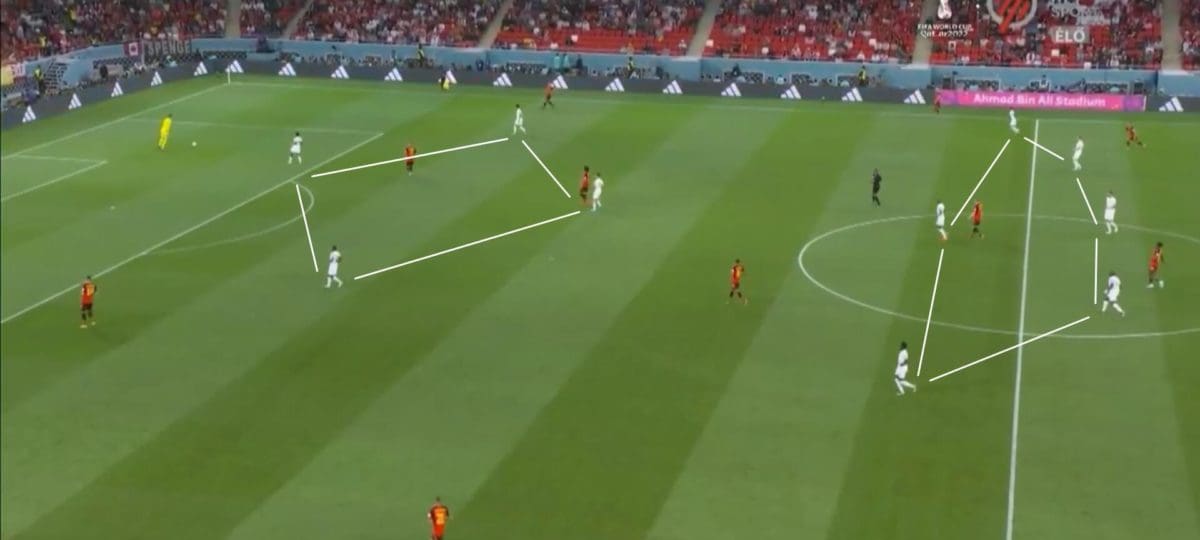


Comments